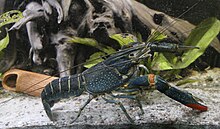Cherax quadricarinatus
| Cherax quadricarinatus | |
|---|---|

| |

| |
| Typical wild form (above) and aquarium form (below) | |
| Scientific classification | |
| Domain: | Eukaryota |
| Kingdom: | Animalia |
| Phylum: | Arthropoda |
| Class: | Malacostraca |
| Order: | Decapoda |
| Suborder: | Pleocyemata |
| Family: | Parastacidae |
| Genus: | Cherax |
| Species: | C. quadricarinatus
|
| Binomial name | |
| Cherax quadricarinatus (Von Martens, 1868)
| |
Cherax quadricarinatus (known by several common names, including Australian red claw crayfish, Queensland red claw, redclaw, tropical blue crayfish, freshwater blueclaw crayfish) is an Australian freshwater crayfish.
Distribution and ecology
C. quadricarinatus is native to permanent freshwater streams, billabongs and lakes on the north coast of the Northern Territory, northeastern Queensland, and Papua New Guinea.[1] Through translocation by humans, the range has spread down to southern Queensland and into the far north of Western Australia. C. quadricarinatus is considered an invasive species, and has established feral populations in South Africa, Mexico, Jamaica, Puerto Rico,[1] Indonesia,[2] Zambia,[3] Malaysia and Singapore.[4]
This tropical crustacean is very tolerant of environmental changes, and is primarily a detritivore.
Description
The colour of C. quadricarinatus ranges from dark brown to blue-green. Their heads have four keels (as inferred by the epithet), and adult males have a distinct red patch on the outer margin of the claws.[5] They can reach up to 600 grams (21 oz).[5]
Life cycle
Females, which are smaller than males, spawn 300–800
Aquaculture
C. quadricarinatus is often kept in aquariums worldwide, and is the only species of crayfish that can be kept in indoor aquaria for ornamental use in the UK (except Scotland) without a licence.[7][8]
It is farmed commercially in Queensland and the Northern Territory, and is harvested at between 35–130 grams (1.2–4.6 oz).[6] C. quadricarinatus is a sought-after product with a delicate crustacean flavour. They are both non-aggressive in nature as well as highly fertile, and can therefore be bred in large numbers in captivity. Time to sexual maturity, and therefore harvest size, is somewhere between six and twelve months in optimally farmed conditions.
References
- ^ . Retrieved 19 November 2021.
- .
- PMID 20162262.
- .
- ^ Government of Queensland. Archived from the originalon 2010-09-22. Retrieved October 4, 2010.
- ^ Government of Queensland. Archived from the originalon 2011-03-12. Retrieved October 4, 2010.
- ^ "Introduce or keep non-native fish and shellfish". gov.uk. His Majesty's Government. 12 October 2022. Retrieved 5 March 2023.
- ^ "Illegal crayfish on the rise in the UK". Practical Fishkeeping. Warners Group Publications Plc. Retrieved 27 February 2023.
External links
 Media related to Cherax quadricarinatus at Wikimedia Commons
Media related to Cherax quadricarinatus at Wikimedia Commons- Freshwater crayfish (Redclaw) fisheries information

